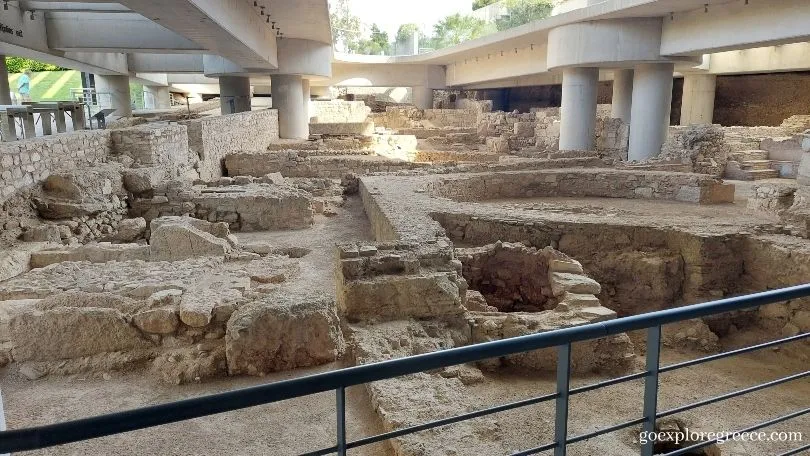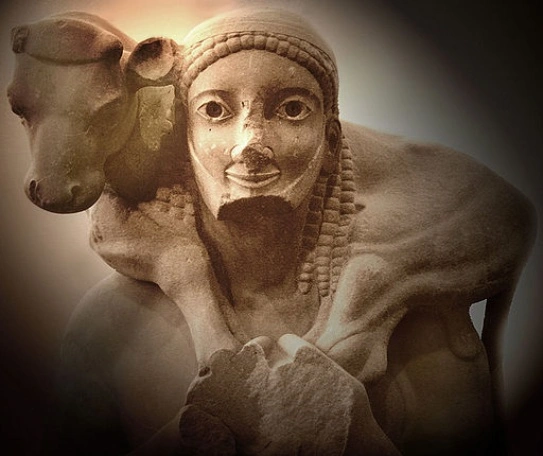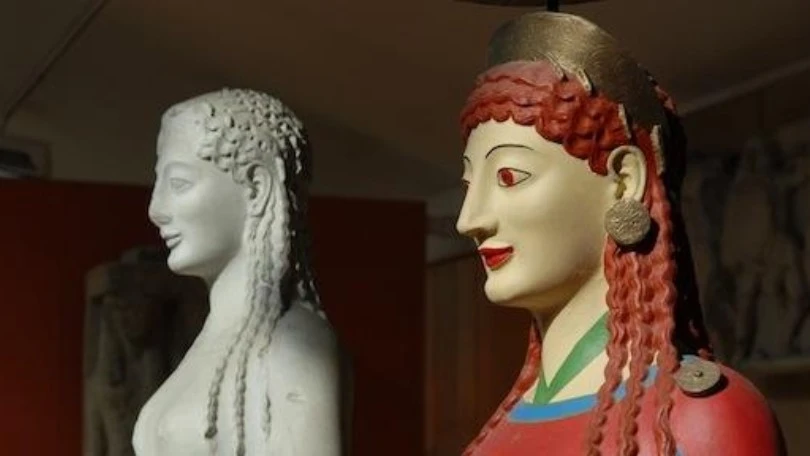So, what are the top things to see at the Acropolis Museum? Ever since the museum was completed in 2009, it has become the most popular of all the museums in Athens, Greece. It is probably the most visited of all the museums in Greece, with around 2 million visiting each year.
The museum has hundreds of exhibits, and quite often, it’s challenging to know which ones to go and see first before the museum becomes overcrowded. So, in this post, I will provide you with my choices for the top things to see at the Acropolis Museum. I’ll also explain a little about the museum, including where it is. It’s also worth noting the museum becomes busy very quickly. Often, there are lines of queues forming at the entrance before it even opens, so I will also explain where you can buy online skip-the-line tickets and tours to beat the queues.
About the Acropolis Museum
Covering 25,000 square metres, this all-glass museum was constructed under three strict conditions:
- To provide breathtaking views of the Acropolis, the Parthenon, and the surrounding hills from transparent glass walls.
- To exhibit the Parthenon sculptures.
- Not interfere with the archaeological findings during excavations.
At it’s base, the museum appears to be floating, as it’s supported by over 100 concrete pillars, which provide an impressive shelter for the site’s archaeological excavation.
The museum hosts its collections across three floors and the below-ground excavation site. Located on the ground floor, the Gallery of the Slopes of the Acropolis houses finds from the monuments and sanctuaries established on the slopes of the Acropolis and objects that Athenians used in everyday life from all historical periods.
The nine-metre high and naturally lit Archaic Gallery in the east and south sections of the first floor hosts the magnificent sculptures inside the first temples on the Acropolis. It also displays the worship’s votive offerings, such as beautiful archaic Korai (depictions of young women), the Hippeis (the horse riders), statues of the goddess Athena, sculptures of male figures, and marble reliefs.
The exhibitions in the Acropolis Museum reach their climax on the third floor, in the Parthenon Gallery. This gallery has a glass case that goes all around the room’s perimeter. Inside it are the relief sculptures of the Parthenon frieze. These depict the Panathenaic procession, exhibited in continuous sequence along the exterior surface of the rectangular concrete core that makes up the bulk of the gallery. There are exactly as many columns in this room as there were originally in the Parthenon. Between these columns are the metopes – marble slabs with relief representations from Greek mythology.
Where is the Acropolis Museum
The museum is opposite the entrance to the Acropolis of Athens, making it an essential stop for tourists and visitors to Athens.
Where to buy skip-the-line tickets and tours for the Acropolis Museum
My choices for the top things to see at the Acropolis Museum
The Parthenon Marbles (Elgin Marbles)

Perhaps the museum’s most well-known monuments are the Parthenon Marbles (also known as the Elgin Marbles), a collection of Classical Greek sculptures. They were made under the supervision of the architect and sculptor Phidias and his assistants in c. 447 to 438 BC, originally as part of the Temple of Athena Nike on the Acropolis Athens.
The third-floor gallery has been designed specifically to showcase the sculptures of the Parthenon. The space is arranged as a glass-walled chamber that wraps around a rectangular core, whose orientation and dimensions match those of the Parthenon.
The outer walls incorporate the relief-carved blocks of the Parthenon temple’s Ionic frieze mounted in the same position as they were on the monument but at a lower height for better viewing. The colossal figures that were once displayed in the building’s two pediments have been mounted on several low pedestals at the east and west side of the gallery in order so they can be visible from all directions.
The exhibition features the original marble sculptures and the plaster copies of those retained in various European museums. The impressive and beautiful glass walls enclosing the gallery provide natural lighting and allow visitors to see the sculptures in relation to the monument from which they come.
The Caryatids

The Caryatids are one of the best-known features and monuments of the Acropolis Museum. Six female figures support the porch of the Erechtheion on the Acropolis in Athens. The figures are life-size and stand in a line, each with her left hand placed on her hip and her right hand holding up a corner of the roof. They wear long pleated dresses and have their hair tied back in a bun.
The Caryatids were initially carved out of marble in the 5th century B.C. by sculptor Kallimachos. They were meant to be replacements for the six wooden statues in front of the Erechtheion. These wooden statues were said to be cursed, as they had been used as beams in a temple dedicated to Poseidon and then removed and reused in another temple. The new marble statues were intended to break the curse.
The Caryatids have been an iconic part of Greek culture for centuries. For many people, they are one of the first things that come to mind when thinking about ancient Greece. In modern times, they have come to represent strength, resilience, beauty, and grace.
The “Daily Life in Ancient Athens” Exhibit

The “Daily Life in Ancient Athens” Exhibit at the Acropolis Museum is a great way to learn about the everyday lives of the people who lived in this city during ancient times. This underground archaeological site features various artefacts used by the Athenians and Greeks in their daily lives, including pottery, tools, and jewellery. Visitors to the museum can also see how the Greeks lived by viewing reconstructions of typical homes and businesses.
An ancient neighbourhood of Athens, Greece is uniquely integrated into the architecture of the Acropolis Museum as another exhibit, interacting with the masterpieces of ancient Greek civilization presented on its floors. Built in the smooth continuity of the rock’s southern slope, it hosts life and activities since the 4th millennium B.C. Until the 12th century A.D., streets, houses, baths, workshops and tombs made up a complex picture of archaeological remains, with the best-preserved ones from late antiquity.
The Calf Bearer

The so-called ‘Calf-Bearer’ statue is one of the most intriguing finds from the Acropolis of Athens. The body was discovered in 1864 during the construction of the old museum, while the base with the feet was found in the same area in 1887. What makes this statue so interesting is its mysterious origin – who was this man, and why was he carrying a calf?
This ancient Greek sculpture is of a bearded man carrying a calf on his shoulders – an offering to the goddess Athena. He’s wearing a thin himation cloth covering his shoulders but exposing the front of his body. His himation was likely painted initially, making it easily distinguishable from his skin tone.
The small animal is held by its feet, with its head tilted towards the master’s head and its tail resting on his arm. His head is covered with a band, securing his long hair back. Even though the irises of his eyes are lost (they were made from a different material), his face remains expressive. He’s known for having the ‘archaic smile’ – a reserved yet amused expression.
The statue’s base features an inscription written in right-to-left Ancient Greek, which tells us it was dedicated by Rhombos, son of Palos. Some scholars believe the statue depicts Rhombos himself – a wealthy Athenian who could afford to dedicate such an expensive marble statue to the Acropolis.
Peplos Kore (Statue of Kore)

The Stature of a Kore, more commonly known as the Peplos Kore, is a beautiful example of Archaic Greek art. The term ‘Kore’ refers to a statue depicting a young woman with a stiff posture and an unwavering gaze. The statue is not entirely straight, as her face is leaned ever so slightly to one side, and she is standing with her weight shifted towards one leg.
The Statue of Kore is now often referred to as the ‘Peplos Kore’ because of the garment she wears, known as the Peplos. The Peplos was fastened in the middle with a belt and on the shoulders with bronze pins. Beneath her Peplos, is a longer chiton, whose slender folds encase her legs.
The colours of her attire have been analyzed through spectrography, and it is said that the belt was once blue and green, while the chiton was blue with a green band at the neck. The Peplos itself was white, with the middle section decorated with vertical rows of small animals, riders and birds shown on squares of red framed by bands of colourful rosettes on a green background. Finally, the peplos borders were decorated by a double band with spirals, floral elements and a chain of volutes and palmettes alternating with lotus.
The Kore’s hair cascades over her shoulders in long, bouncy curls, while at the back, it is fastened with a dainty ribbon. The rich red paint that covers her locks today is an undercoat; the final brown colour was applied over it. This same hue of red also paints her irises and lips. At the same time, her pupils, eyelids, and eyebrows were probably accented with black paint.
South Frieze (corner block a.) of the Temple of Athena Nike

The south frieze of the Temple of Athena Nike is believed to depict the Ancient Greeks’ victory battle against the Persians at the Battle of Marathon in Ancient Greece 490 BC – an event in which Athens played a crucial role. Carved into the corner block ‘a’ of the frieze are striking reliefs depicting scenes from this historic clash. On the left, a Greek hoplite comes to the aid of a comrade who has been hit by an arrow fired by a Persian archer on the right. In the centre, another Greek chases after a Persian horseman while another Persian lies dead on the ground. This temple frieze provides a fascinating glimpse into one of the most important battles in Ancient Greek history.
The frieze comprises fourteen blocks, each with a different scene depicted on its sides. Nine of these blocks are currently in the Acropolis Museum, one has been lost, and four are still in the British Museum in London after they were removed by Thomas Bruce, lord of Elgin, around the start of the 19th century.
In 1687, the Ottomans dismantled the temple and parapet of Athena Nike. The material was used to reinforce a gun emplacement and fortify the west side of the Acropolis against attacks by Venetians under the command of General Francesco Morosini.
The Kritios Boy (Kritian Boy)

The main part (the torso) of the statue was discovered in 1865-1866, southeast of the Parthenon. The head of the statue was found in 1888 near the south walls of the Acropolis. It is a significant work of ancient Greek art and characteristic of the ‘Severe Style’. Archaeologists have given it the nickname ‘Kritios Boy’, after the sculptor who is believed to have created it.
This statue is shrouded in mystery – we don’t know who it represents. Some scholars believe he was a young athlete, perhaps the winner of an event at the Greater Panathenaia. Others claim he was a hero, most likely Theseus. There is evidence that the statue was dedicated to the Acropolis around 476/5 BC when Kimon transferred Theseus’ bones from Skyros to Athens. No matter who he was, this statue is interesting and worth studying.
He is shown standing tall and proud in the nude, with his weight supported on his left leg. His right leg remains loose and bent at the knee in the characteristic Severe Style posture. His expression is solemn and commanding. Though his original eyes have not survived, they would have added to his regal bearing. His hair is closely cropped around his head, with a few strands falling down on his temples and neck. Traces of red dye are still visible, showing that he was once a handsome young man.
Conclusion
Well, there you have it, my top choices for the top things to see at the Acropolis Museum in Athens. If you do decide to have a holiday in Athens, Greece, then I hope you add to your list of things to do in Athens a visit to the museum, and maybe take my advice on what to see.

